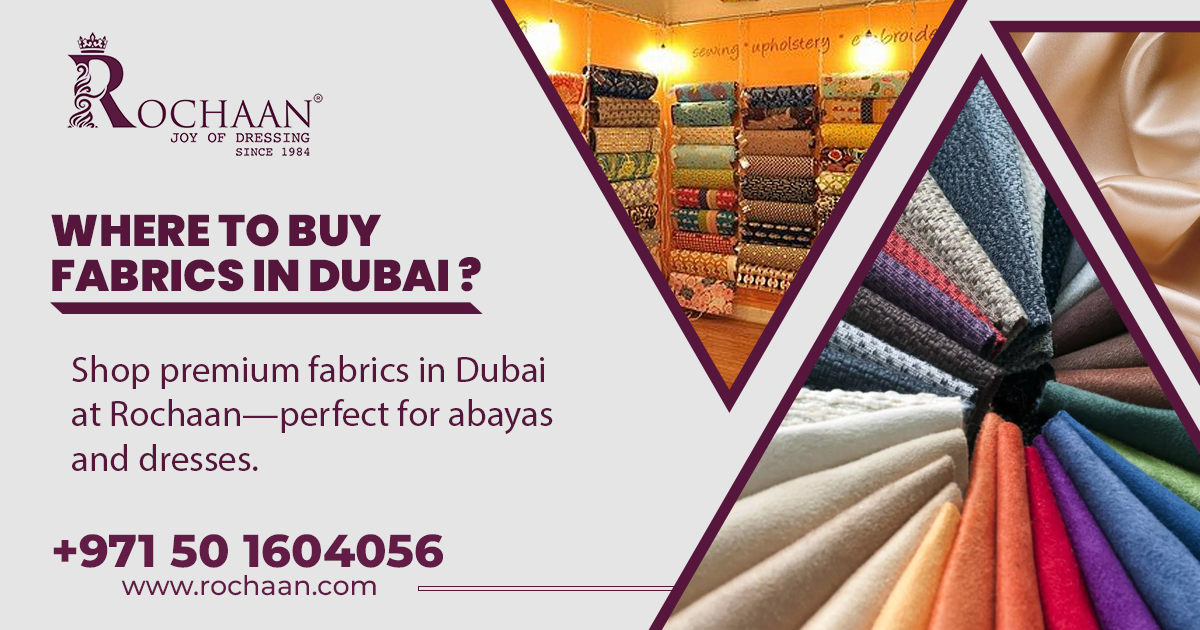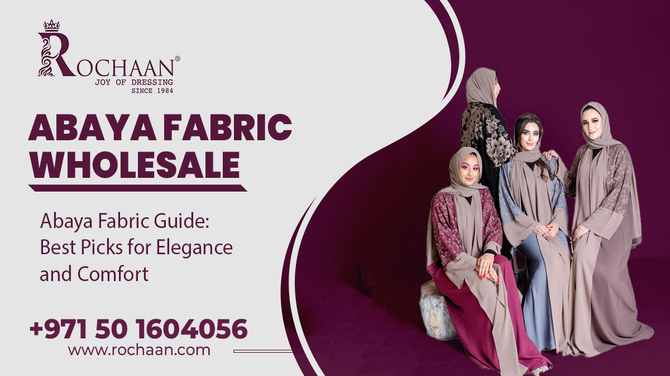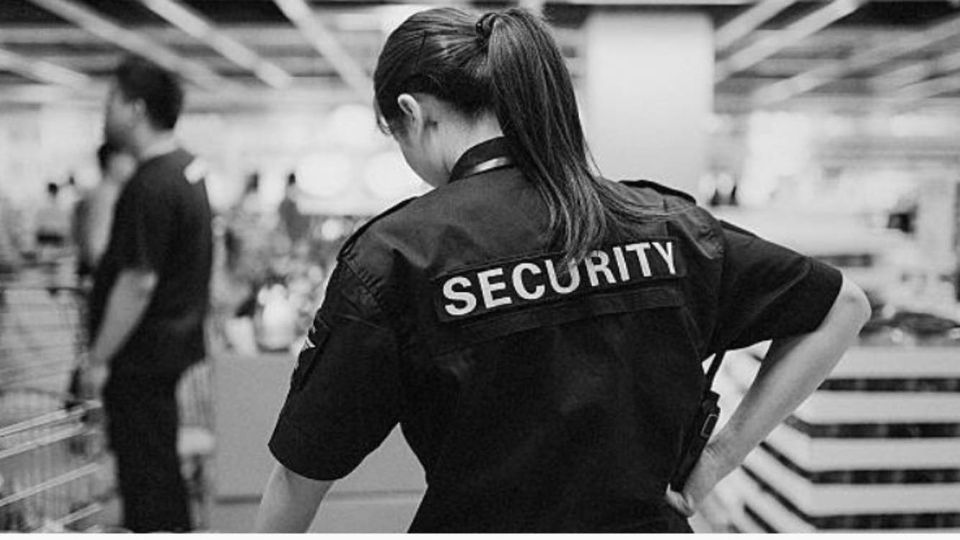Abayas are timeless garments that symbolize elegance, modesty, and tradition in many cultures, particularly in the Middle East. Over time, the abaya has evolved into a fashion statement, blending both traditional and modern design elements. One of the most important factors in creating the perfect abaya is the choice of fabric. The right fabric not only influences the garment’s appearance but also affects its comfort, durability, and suitability for different occasions and climates.

In this comprehensive guide, we will explore some of the best fabrics for abayas, focusing on their unique characteristics, benefits, and suitability for various seasons and events. Whether you’re looking for a fabric that exudes luxury, provides comfort for everyday wear, or is lightweight for hot climates, this guide will help you make an informed decision.
Nida Fabric: The Luxe Choice for Abayas
Nida is one of the most popular fabrics used in abaya production, particularly in the UAE. It is known for its soft texture, lightweight feel, and luxurious appearance, making it a top choice for women who want both comfort and elegance.
Characteristics:
Soft and Silky Feel: Nida fabric feels smooth and luxurious against the skin, offering comfort even during extended wear.
Breathable: Despite being thicker than some other fabrics, Nida is breathable and suitable for warm climates.
Matte Finish: Nida has a subtle, matte finish that gives abayas a polished, high-end look.
Variety: There are several variations of Nida fabric, including Japanese Nida, Korean Nida, and premium Nida, each offering slightly different textures and weights.
Best For:
Nida is ideal for both everyday wear and formal events. Its luxurious feel and appearance make it perfect for special occasions, while its lightweight nature ensures comfort during daily use, especially in warm weather.
Care:
To maintain its softness and luxurious feel, Nida should be hand washed or machine washed on a gentle cycle. Avoid using high heat when ironing to prevent damage to the fabric.
Crepe Fabric: The Versatile and Durable Option
Crepe is another widely used fabric for abayas, known for its textured surface, durability, and versatility. It is a fabric that offers a good balance between elegance and practicality, making it a favorite among women who want an abaya that can transition from casual to formal settings.
Characteristics:
Textured Surface: Crepe has a slightly rough texture, which adds dimension to the fabric and creates a unique drape.
Durable: Crepe is a strong fabric that resists wrinkling, making it ideal for everyday wear.
Lightweight: Despite its durability, crepe is lightweight and comfortable for wear in warmer climates.
Variety of Options: Crepe comes in different weights and textures, from light crepe for a flowy look to heavier crepe for more structured designs.
Best For:
Crepe is suitable for both casual and formal abayas. Its durability makes it perfect for everyday wear, while its textured finish adds elegance, making it versatile enough for more formal occasions.
Care:
Crepe abayas are relatively easy to care for. They can be hand washed or machine washed on a gentle cycle. Since crepe is resistant to wrinkles, it requires minimal ironing.
Chiffon: The Light and Elegant Fabric
Chiffon is a sheer, lightweight fabric that is often used in abayas as an overlay or for decorative elements. Its delicate and flowing nature adds an ethereal quality to abayas, making it a popular choice for special occasions.
Characteristics:
Sheer and Lightweight: Chiffon is extremely light and has a semi-transparent quality, which makes it perfect for layering.
Elegant Drape: The fabric flows gracefully, creating a soft, feminine look.
Breathable: Chiffon is breathable and comfortable to wear, especially in hot climates.
Best For:
Chiffon is typically used for formal or evening abayas, especially for layering or creating flowing sleeves and details. It is often paired with heavier fabrics to add dimension and texture.
Care:
Chiffon is a delicate fabric that requires special care. It should be hand washed or washed on a gentle cycle. Due to its sheer nature, it is important to avoid excessive wringing or exposure to high heat.
Satin: The Fabric of Luxury
Satin is synonymous with luxury and opulence. Its smooth, glossy surface and soft texture make it a go-to fabric for abayas meant for special occasions. Satin abayas are often worn for events like weddings, parties, and formal gatherings, as the fabric’s sheen adds an element of glamour.
Characteristics:
Glossy Finish: Satin’s signature sheen gives abayas a high-end, luxurious appearance.
Silky Feel: The smooth texture of satin feels soft and comfortable against the skin.
Weight: Satin is heavier than some other fabrics, making it more suitable for cooler weather or indoor events.
Best For:
Satin is perfect for formal abayas designed for special occasions. Its luxurious sheen and drape make it a standout fabric for evening wear, particularly in abayas that are meant to make a statement.
Care:
Satin abayas should be dry cleaned or hand washed to maintain their glossy appearance. If ironing is necessary, it should be done on a low setting or with a cloth placed over the fabric to avoid damaging the sheen.
Jersey Fabric: Comfort and Flexibility
Jersey is a stretchy, knit fabric that has become increasingly popular for casual abayas. Known for its flexibility and comfort, jersey is perfect for women who want an abaya that is easy to wear and move in.
Characteristics:
Stretchable: Jersey fabric has a natural stretch, providing flexibility and ease of movement.
Soft and Comfortable: Jersey is soft and comfortable, making it ideal for everyday wear.
Low Maintenance: Jersey abayas are easy to care for and maintain, as the fabric is durable and resistant to wrinkles.
Best For:
Jersey is ideal for casual, everyday abayas. Its stretchiness and comfort make it perfect for women with active lifestyles or for those who prioritize comfort.
Care:
Jersey abayas can be machine washed on a gentle cycle and hung to dry. The fabric is relatively low maintenance and doesn’t require frequent ironing.
Velvet: Rich and Regal
Velvet is a plush, thick fabric that exudes richness and warmth. While it is not commonly worn in warm climates, velvet abayas are perfect for winter months or indoor events where a more regal and opulent look is desired.
Characteristics:
Soft and Plush: Velvet is known for its soft, rich texture, which feels luxurious against the skin.
Thick and Warm: Due to its thickness, velvet provides warmth and is ideal for cooler weather.
Elegant and Regal: The deep, rich texture of velvet makes it perfect for formal, royal-like designs.
Best For:
Velvet is best suited for winter abayas or for special occasions where a formal, elegant appearance is required. It is often used in abayas with intricate embellishments, adding to its luxurious appeal.
Care:
Velvet abayas should be dry cleaned to maintain their texture and appearance. Special care should be taken to avoid crushing the pile of the fabric.
Linen: Lightweight and Breathable
Linen is a natural fabric that is highly breathable and perfect for hot climates. While it is not as common as Nida or crepe, linen is an excellent choice for summer abayas due to its lightweight and airy nature.
Characteristics:
Breathable: Linen allows air to circulate, keeping the wearer cool in hot weather.
Natural Texture: The slightly rough texture of linen gives abayas a casual, relaxed appearance.
Eco-Friendly: Linen is made from natural fibers, making it an environmentally friendly option.
Best For:
Linen is ideal for summer or casual abayas. Its lightweight nature and breathability make it perfect for staying cool in hot, humid climates like Dubai.
Care:
Linen should be washed in cold water and hung to dry. It can wrinkle easily, so it’s important to iron linen abayas while they are still slightly damp for a smooth finish.
Silk: The Epitome of Elegance
Silk is a luxurious fabric known for its smooth texture and elegant appearance. Silk abayas are often reserved for the most formal of occasions due to the fabric’s delicate nature and high cost.
Characteristics:
Soft and Smooth: Silk has a delicate, smooth texture that feels luxurious against the skin.
Shiny Finish: Silk’s natural sheen adds to its elegant appearance, making it perfect for formal events.
Lightweight: Despite its luxurious appearance, silk is lightweight and comfortable to wear.
Best For:
Silk is best for formal abayas designed for weddings, parties, and other high-end events. The fabric’s sheen and softness make it a standout choice for evening wear.
Care:
Silk requires delicate care and should be dry cleaned to preserve its quality. If hand washing is necessary, use cold water and avoid wringing or twisting the fabric.
Conclusion
Choosing the right fabric for an abaya is essential to achieving the desired look, comfort, and functionality. Whether you prioritize luxury, durability, or breathability, there are plenty of fabric options to suit your needs. Nida, crepe, and chiffon are excellent choices for women looking for versatility and comfort, while satin, velvet, and silk are perfect for more formal and luxurious designs. Jersey and linen offer casual and breathable options for everyday wear.
Ultimately, the best fabric for an abaya depends on personal preferences, the occasion, and the climate in which it will be worn. With so many beautiful and high-quality fabrics available, you can find the perfect abaya that combines tradition with modern style.




